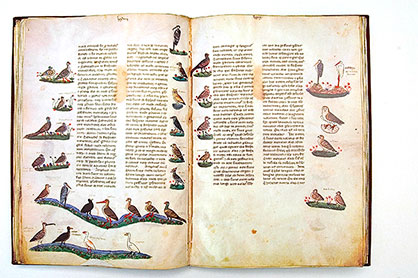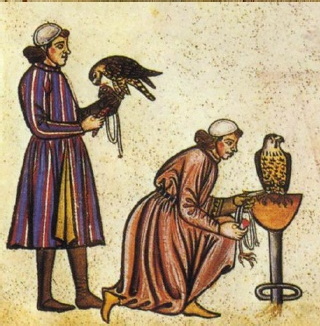Despite their association with school courses, and the ready availability of information online, textbooks have long been—and still are—useful for working ornithologists. The OED says that a textbook is : A book used as a standard work for the study of a particular subject. By that definition, textbooks of ornithology have been with us for almost eight centuries, and are still immensely useful to student and professional ornithologists. Throughout my professional life I have maintained a small collection of hard-copy textbooks—statistics, ornithology, behavioural ecology, evolution, genetics, biochemistry—that I refer to all the time when writing scientific papers and articles, even though the majority of what I read is online or in PDFs.
The first ornithology textbook, arguably, was written by Frederick II of Hohenstaufen sometime around 1248 CE. Its title, De Arte Venandi cum Avibus, is often translated as The Art of Falconry, which is reasonable, but the title is more correctly translated as The Art of Hunting with Birds. As the title suggests, the book is largely focussed on methods for using falcons to hunt, but the first chapter is essentially a textbook of ornithology.

Frederick II had quite the resumé as he was consecutively King of Sicily, Germany, Burgundy, Italy, and Jerusalem, with a simultaneous stint as Holy Roman Emperor in the 30 years before he died at the age of 56. He has often been referred to as stupor mundi et immutator mirabilis (‘astonishment of the world and marvellous transformer’) and his accomplishments, conquests, writings, insights, and arrogance were all truly astonishing. As was his fathering of at least 19 children with four ‘wives’ and no fewer than eight mistresses. Frederick is said to have kept at least 50 falcons at court, and falconry was clearly his favourite hobby, after procreation.

Frederick’s original manuscript (a codex) disappeared during the 1248 Siege of Parma, Italy, but there are several early copies of that original—in two different versions, one of two ‘books’ and the other of six—now held in at least 12 libraries in Europe. The earliest of these were commissioned and probably edited by Frederick’s son Manfred, who was also a keen falconer.
All of those early copies are manuscripts, handwritten codices. One of the best-known is an illuminated codex of the two-book version, now in the Vatican Library. The pictures from that illuminated manuscript are often shown in books and articles about the early history of ornithology [1]. The text of the six-book version is presumably better known for it has been translated into French, German and English over a 700-year period after the original Latin codex was written.
In the six-book version, the first book is a general treatment on the anatomy and lives of birds, describing Frederick’s extensive observations and experiments. Frederick was truly a ‘Renaissance Man’, about 300 years before his time, as he based his writings on direct observation of the natural world rather than relying on an ‘authority’ like Aristotle (with whom Frederick often disagreed). When he could not make a direct observation himself, Frederick consulted with experts and often used inductive reasoning to make his conclusions.
Frederick was an inveterate experimenter and his experiments with humans were horrible, to say the least. He also tried to see if chicken eggs could hatch by the heat of the sun alone [2], and whether blindfolded vultures could find food, to see if they had a keen sense of smell. Like Audubon [3], six centuries later, Frederick concluded, incorrectly, that:
A vulture is not attracted to his carrion food by his sense of smell, although some writers maintain that he is, but relies on his eyesight. We have ourselves many times experimented and observed that an assemblage of seeled [eyelids stitched shut] vultures, whose noses were not stopped up, did not scent the meat cast before them. [4]
Frederick’s book 1 of the six-book edition is a remarkable, and remarkably accurate, treatise on the ecology, behaviour and anatomy of birds in 56 chapters. In chapter 46 (Of the Colors of Avian Plumage), for example, he notes that some species change colour with age, that some species change the colours of their plumage and soft parts for the breeding season, that herons acquire a powder down just prior to mating, and that there are ecological differences between precocial and altricial offspring.
The remainder of the book focuses on falcons, with an introduction to book 1 about falconry as a noble pursuit, book 2 on how to catch and train birds of prey, book 3 about the different kinds of lures used by falconers, book 4 on how to hunt cranes with Gyrfalcons, book 5 on hunting herons with Sacre Falcons, and the final book on hunting water birds with Peregrines.
Frederick fought wars with the Pope and was variously labelled a heretic, the antichrist, and the devil. Not surprisingly, then, his work was suppressed (hidden?) by the Catholic Church and remained virtually unknown to those interested in birds for the next 350 years. In the early 14th century, the two-book codex was translated into French, and in 1596 the Latin version was first printed and made more widely available. It was not, however, even mentioned in the ornithological works of Gesner and Aldrovandi in the 16th century, and gets only a brief quotation in the 17th in the descriptions of falcons in Ray’s Ornithology.

Frederick’s codex was rediscovered in 1700s when one Latin edition and two German translations of the 2-book version were produced, including a copy with useful notes by Johann Gottlob Schneider in 1788 [5]. Even then, Frederick’s work was largely ignored, getting only a passing mention in Newton’s Dictionary of Birds in the late 1800s. Then, in the 1930s, Marjorie Fyfe and the indefatigable Casey Wood embarked on an English translation of the Latin six-book version. That translation and much additional material was published ina book in 1943, a year after Wood died. This is a remarkable book that deserves a separate essay of its own.
So was The Art of Falconry really the first textbook of ornithology? Looking at the content you would have to say ‘yes’. But is it really a textbook if nobody read it or used it for study (‘If a tree falls in a forest…?’). By that criterion the answer would have to be an emphatic ‘no’, and John Ray’s Ornithology would be a better candidate for the title of first ornithology textbook. The first edition of Ornithology was published in Latin in 1676, presumably in that language because it was intended for scholars. At the urging of his colleagues, however, Ray immediately produced a somewhat expanded English version in 1678, a version that became THE textbook of ornithology for the next 200 years, and is still worth reading today. Wood and Fyfe’s translation of Frederick is also worth reading and the 1961 reprint is still available on Amazon at $100 US.
SOURCES
-
Aldrovandi U (1599) Ornithologiae hoc est de avibus historiae. Bologna: Apud Franciscum de Franciscis Senensem.
-
Birkhead TR (2008) The wisdom of birds: an illustrated history of ornithology. London: Bloomsbury.
-
Birkhead T (2012) Bird Sense. UK: Bloomsbury.
-
Brunner B (2017) Birdmania: A Remarkable Passion for Birds. Vancouver: Greystone Books.
-
Gesner C (1555) Historia Animalium. Liber 3 qui est de avium natura. Frankfurt: Andreae Cambieriano.
-
Haskins CH (1921) The “De Arte Venandi cum Avibus” of the Emperor Frederick II. English Historical Review 36: 334 – 355.
-
Ray J (1676) Ornithologiae libri tres: in quibus aves omnes hactenus cognitae in methodum naturis suis convenientem redactae accuratè descripbuntur, descriptiones iconibus. London: John Martyn.
-
Ray J (1678) The Ornithology of Francis Willughby. London: John Martyn.
-
Walters M (2004) A concise history of ornithology. London: Christopher Helm.
- Wood CA, Fyfe FM, translators (1943) The Art of Falconry; Being the De Arte Venandi cum Avibus by Frederick II of Hohenstaufen. Stanford: Stanford University Press.
Footnotes
- pictures from the illuminated manuscript: in Walters (2003), Birkhead (2008), Brunner (2017)
- eggs hatching from heat of sun: see Wood and Fyfe 1943 page 53. Haskins (1921: 342) suggests that the experiments were conducted on ostrich eggs, but Frederick makes it clear here that he was (incorrectly) certain that ostriches did not incubate their eggs for fear of breaking them, and instead they were incubated by the sun. He goes on to say that in Egypt the eggs of the barnyard fowl had been observed to be incubated by the heat of the sun. He says he summoned experts from Egypt to test this but he does not record what they discovered.
- Audubon’s experiments with the vulture’s sense of smell: see Birkhead (2012)
- quotation about vultures: from page 22 of the English translation by Wood and Fyfe (1943)
- Latin edition and German translations: see Wood and Fyfe (1943: lvii)
COMMENTS